by Helen Kembery
Taken from the Orwell Observer, newsletter of the RSPB Ipswich Local Group, 2006
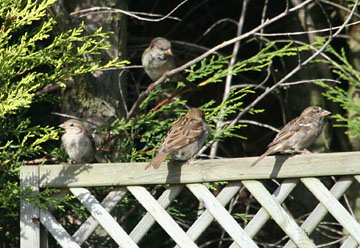
The humble house sparrow has accompanied us for thousands of years, and until as recently as the 1970s there were so many that it was inconceivable that they would ever be in danger. They were considered beneath counting for the early bird surveys, but in the last decade or so something has been doing for our house sparrows. In some of our great cities numbers are down drastically. Across large swathes of urban London and some other European cities the cheerful chatter of sparrows is heard less and less as the last chirp rings out as their density falls below a sustainable value.
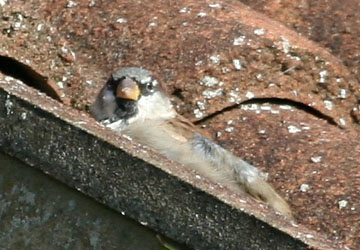
Surveying sparrows is both easy, in that they are noisy and not overly shy, and hard, because of their association with Man. It is not the way to win friends and influence people to look at their houses with binoculars! Fortunately sparrows seem to interest many of our Group members, and I would like to thank you for an excellent response to the survey – about a quarter of the membership responded with observations.
As the county town of Suffolk Ipswich is probably the most urban location in the county, and so it was that I enlisted the help of our Local Group to see how our local sparrows were doing. The results are a curious mixture of good news and not so good news. The good news is that sparrows are widespread across the town, with the exception of the town centre. As a result we have good coverage of sightings from most parts of the town, and as you can see from the map the Ipswich sparrow population is widespread, with the exception of the town centre. Although Christchurch Park is bordered on three sides by residential areas, I have never observed a sparrow in the park!
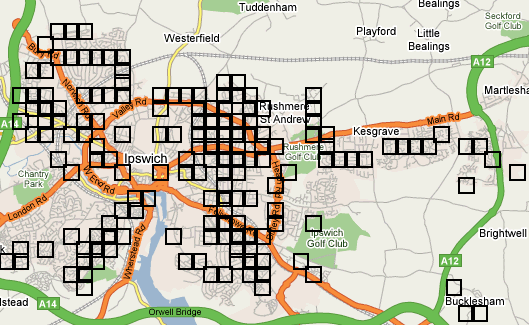
300m squares with positive sightings of one or more sparrows across Ipswich
The obvious explanation for the absence from the town centre is that there are no residential properties there. However, in Europe I have observed sparrows penetrate the business districts of larger urban areas than Ipswich. When drawing money from an ATM in the centre of Lugano, I heard a chirp, and looked up to see a cock sparrow on a second floor window. British cities have taken more steps to eliminate the mess of pigeons from city centre buildings using netting and spikes to discourage roosting Finding locations where sparrows are absent is more difficult. I rely on reports from members that there were no sparrows in an area, as I cannot make this observation in a mobile survey. The sparrows might simply have been elsewhere at the time of survey.
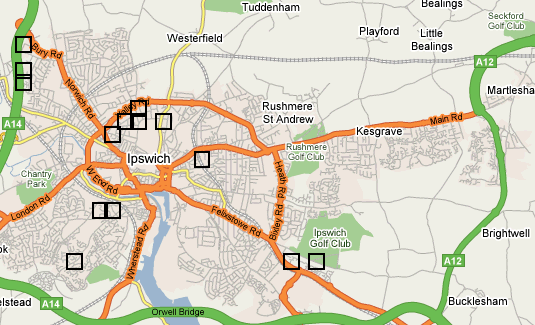
300m squares with reports of no sparrows present in Ipswich
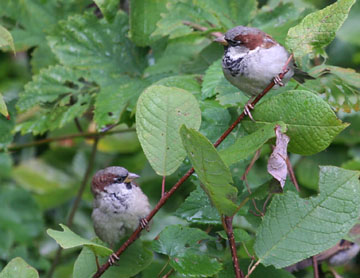
The negative reports are unusual – Valley Road, for instance, has a lot of vegetation and a fair amount of water and it is surprising to find a cluster of negative sightings there. Likewise near the golf club, which seems otherwise good sparrow territory. From the survey it seems that sparrows are at their densest in the suburban areas, particularly where there are semidetached houses built before the 1980s, preferably with wooden bargeboards and soffits. Privet hedges, ivy, and holly trees seem to benefit sparrows. I observed two roosts in established holly trees, and during the breeding season I saw privet hedges containing about twenty sparrows. However, these things are becoming rarer. Front gardens are being removed to create hard standing for cars, and hedges are often lost in the process, though it is often possible to keep the hedge and create a parking place. Nesting sites are lost as uPVC replaces wooden soffits. We have had this done too, but we have placed an RSPB sparrow box near the eaves so that a sparrow may find a home in a congenial place. We should not be complacent about our Ipswich sparrows, however, less good news seems to lurk in some of the comments I received from members.
"never more than two seen at a time, yet 5/6 years ago we would have 20+ in garden - adults + fledglings"
"Used to nest in canopy of petrol station, now pulled down"
"[near town centre location], numbers have declined over the last 15 years"
I would like to thank all the Local Group members that helped me gather a feeling for the state of our town sparrows. The house sparrow is a bird I have taken for granted all my life, and it is only recently that I discovered that its numbers have declined by more than half in the last two decades. The RSPB has sponsored research into the decline, however it has been hard to separate the variables and identify a single cause. Some evidence has recently come out that some of the problem is a dearth of insects in the summer to feed the young. Unlike the adults, which are specialists in grain, the young need insect food since they have no other source of water. It appears that the adults are having difficulty in finding enough insects in our modern gardens, and many of the young are starving in the nest, particularly in the June to July period.
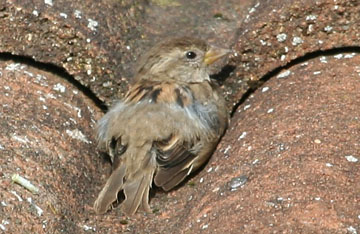
We have fed our local sparrows mealworms through this years breeding season and have been rewarded with a doubling of observed numbers after the breeding season, compared to the same time last year where we fed only seed and nuts. We have about 30 in our back garden that is about the size of four car parking spaces. Of course it remains to be seen how many of these will survive through the winter, but so far the results seems to concord with the RSPBs tentative conclusion that in urban areas chick mortality, rather than adult mortality, is the key issue.
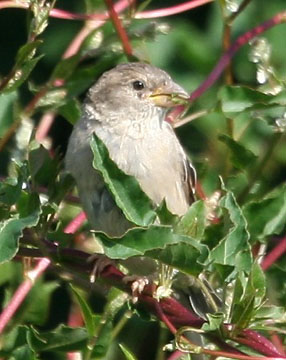
I will continue to track the Ipswich sparrow population building on these results. Hopefully this will not be the narrative of a decline of our once thriving sparrow population. The results are on the Local Group website, where there are links to some of the RSPBs research into the decline of the house sparrow and steps you can take to improve the odds for your local sparrows.
The house sparrow may not be the most colourful bird, and its song doesn’t compare with the virtuoso performance of the nightingale. Yet for all that, it has been out companion for many years, and knows us well, having travelled with Man for over fifty human generations. Hopefully the friendly chirp of sparrows will continue to ring across the roof tiles in Ipswich for generations to come. Part of their charm is their unassuming intimacy with our ways, such as this house sparrow perched on a hedge, waiting to take its chance when the diners leave the nearby table.
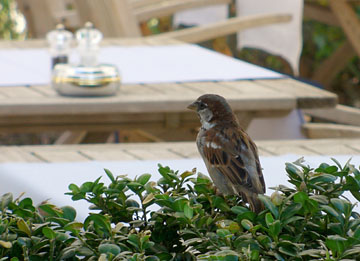
Sparrows get bolder as numbers increase - this photograph was taken at a café in Lucerne, where the sparrows have not left the city centre and are present in large numbers roosting in the avenues of beech trees that line the lakeside boulevards. I have not observed such concentrations anywhere in Ipswich. The sparrow is a very social bird, always observed with others of its kind, and as their density falls they seem to become much more careful - our sparrows appear to be much more timid and wary of humans than those at this café, or indeed the sparrows that I recall people feeding in London parks only a couple of decades ago.
You can read more about the Sparrow Survey and links to formal research into the decline of urban house sparrows.
Of course this survey does not have the scientific rigour of a BTO study, being conducted over a short period time only and without normalising effort. The RSPB yearly bird count gives a more accurate picture over time and they have overall noticed a decline of 58% since the 70s. However, this gives us a snapshot of Ipswich sparrows in 2006 and it would be interesting to repeat it in a few years time.